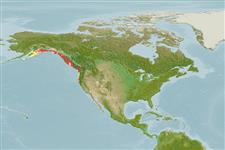Common names from other countries
Environment: milieu / climate zone / depth range / distribution range
Ecologie
; diepteverspreiding 0 - 125 m (Ref. 95072). Temperate; 71°N - 32°N, 141°E - 117°W
Arctic and Northern Pacific.
Length at first maturity / Size / Gewicht / Leeftijd
Maturity: Lm ?, range 4 - 5 cm Max length : 19.0 cm WD mannelijk/geslacht niet bekend; (Ref. 128652); Maximaal vermelde leeftijd: 200 jaren (Ref. 128652)
Harvestable size is around 9-10 cm test diameter (4-5 years in age) (Ref. 121955). Found in relatively high energy environments on open rocky intertidal and subtidal shores (Ref. 121802). Herbivorous grazer in nearshore habitats (Ref. 121801). Kelp forest species (Ref. 121804). Found in concentrated amount at the apex of the holdfast of the giant kelp Macrocystis pyrifera (Ref. 121803).
Members of the class Echinoidea are gonochoric. Fertilization is external. Brooding is common, eggs are held either on the peristome, around the periproct or deep into the concavities on the petaloids. Life cycle: Embryos develop into planktotrophic larvae (echinoplateus) and live for several months before they sink to the bottom using their tube feet to adhere on the ground where they metamorphose into young urchins.
Bisby, F.A., M.A. Ruggiero, K.L. Wilson, M. Cachuela-Palacio, S.W. Kimani, Y.R. Roskov, A. Soulier-Perkins and J. van Hertum. 2005. (Ref. 19)
Status op de Rode Lijst van het IUCN (Ref. 130435)
Status bij CITES (Ref. 108899)
Not Evaluated
Not Evaluated
Gebruik door de mens
Visserij: commercieel
| FishSource |
Tools
Internet-bronnen
Estimates based on models
Preferred temperature
(Ref.
115969): 4.1 - 10.7, mean 8.6 (based on 90 cells).
Weerstandsvermogen
laag, minimale populatieverdubbelingstijd 4,5-14 jaar (K=0.08).
